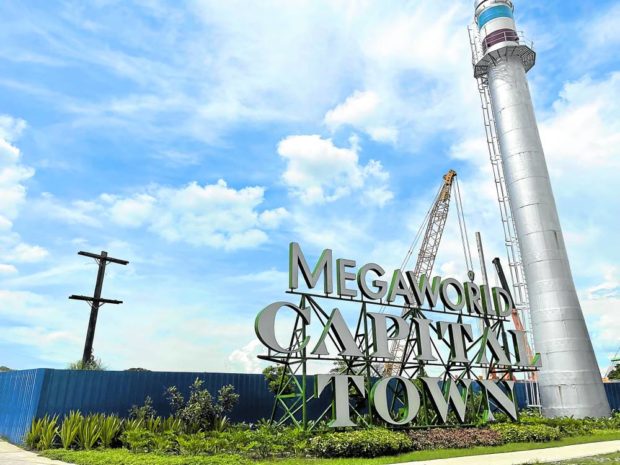‘Missing’ icon of Pampanga sugar economy surfaces

FAMILIAR VIEW Three chimneys inside the mill of the old Pampanga Sugar Development Co. in the City of San Fernando, Pampanga, disappeared from residents’ view in June until this one surfaced recently at the facade of the property. —TONETTE OREJAS
CITY OF SAN FERNANDO — One of the three chimneys, which heritage advocates saved from demolition and regarded as remnants of Pampanga’s sugar economy in the 20th century, has been repaired and erected in a mill-turned-township here.
Built in 1964, the 30-meter-high Chimney 3 was relocated in late July to the gate of Capital Town, the ongoing land development project of Megaworld Capital Town Inc. (MCTI) of property giant Megaworld and former mill owner Pampanga Sugar Development Co. (Pasudeco).
On Aug. 22, workers were seen fixing the base of this chimney right beside the road leading to the provincial capitol. It was transferred less than a kilometer from where it used to stand in the first Filipino-financed mill that began operations in 1922.The two other chimneys have yet to rise in new locations.
Megaworld, in a statement on Aug. 12, said Chimneys 1 and 2 were found by a third-party consultant to be “structurally unstable and may cause hazard to the public.”
Towering at 45.73 m, these were established between 1918 and 1922, according to a report in 2015 by a consulting firm of Pasudeco.
Article continues after this advertisementBaffled
Several residents in Barangay Sto. Niño and San Juan here were baffled when the chimneys reportedly went missing from view, asking for their whereabouts.
Article continues after this advertisementThe top of Chimney 1 was very unstable and its concrete base suffered foundation cracks, a master plan presented to the technical working council (TWC) of the National Commission for Culture and the Arts, National Museum and National Historical Commission of the Philippines showed.
It said Chimney 2 collapsed after an earthquake occurred late January 2015.
Megaworld said both chimneys would be rebuilt and moved to different sites as key features inside the 35.6-hectare township.The bricks, metal sheets and other pieces of Chimney 2 were “being kept safely on-site” for the soon-to-be constructed Capital Mall, where a museum is planned.
“It will pay homage to the history and heritage of Pasudeco,” it added.
The three chimneys were last seen together in June 2017 when MCTI secured them from falling by fastening cables on them.
A private contractor demolished the mill after it turned out to be in bad shape when it was dug out of Mt. Pinatubo’s 1995 lahar flows, a check with Pasudeco showed.
In June 2018, the city government averted a plan by another contractor to demolish the chimneys for safety reasons.
The images of the chimneys are still part of the official logos of the province and the capital city.
Lifted
The city government became the regulator of Capital Town after the TWC lifted the presumption that Pasudeco’s properties were heritage structures, being over 50 years old, an NCCA letter showed. Because Pasudeco is located in San Fernando’s heritage district, Megaworld has to obtain permits from the local government.
The master plan presented to the TWC regarded the chimneys as an “icon” of Pasudeco heritage.
Ivan Henares, Philippine committee president of the International Committee for the Conservation of Industrial Heritage, found that to be problematic.
“For the Capital Town development, earlier promotional materials had claimed that they were inspired by Kapampangan architecture. But upon investigation, there was nothing Kapampangan about the planned buildings,” Henares said in a text message.
“We had advised them to stop making these misrepresentations,” he added, calling the demolition of the mill itself “a very unfortunate incident.”